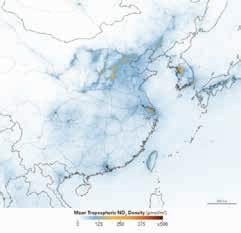
2 minute read
THE UPSIDE
THE UPSIDE OF LOCKDOWNS Air Gets Cleaner Around the Globe
by Kimberly B. Whittle
Around the world, the COVID-19 ham, Bristol and Cardiff , NO 2 and fi ne pandemic has changed the way particulate pollutant levels dropped by a millions of people live their daythird to half, with large declines recorded in to-day lives, but despite their dire conseother cities. Th ese are the two air pollutquences, government-mandated lockants that have the biggest health impacts on downs have had an unintended positive people, says James Lee, professor of atmoconsequence: cleaner air. spheric chemistry at the University of York In China, as major cities shuttered and research fellow at the National Centre factories and reduced transportation for Atmospheric Science. earlier this year, experts found that carbon Th e U.S. has been part of these emissions dropped by about 100 million trends, as well. In Los Angeles, known for tons over a two-week period. Scientists its smog, the air quality index improved by at the Royal Belgian Institute for Space about 20 percent during March. According Aeronomy, in Brussels, are using satellite to Yifang Zhu, a professor at the University measurements of air quality to estimate of California (UC) Los Angeles Fielding the changes in nitrogen dioxide (NO 2 )—a School of Public Health, during March, pollutant emitted into the air when fossil the region recorded the longest stretch of fuels are burned—over the major epicen“good” air quality that it has experienced ters of the outbreak. Th eir research shows for 25 years. that NO 2 pollution over Chinese cities NASA has observed signifi cant air decreased by an average of 40 percent durquality improvements in other parts of ing the lockdown compared to the same the U.S., as well. Satellite data for March period in 2019. showed that the mid-Atlantic and North Across the United Kingdom, the east regions had the lowest monthly atreduction in traffi c and industry similarly mospheric levels of NO 2 that month since impacted the climate. Within the fi rst six 2005. Data on NO 2 from the Aura Ozone weeks of lockdowns, in London, BirmingMonitoring Instrument over the Northeast in March indicated that levels of the pollutant in March of this year were about 30 percent lower on average across the region of the I-95 corridor from Washington, D.C., to Boston than the mean of the previous fi ve years. Another immediate benefi t of the reduction in pollutants is their eff ect on the pandemic itself. Public health experts agree people that have higher long-term exposure to fi ne particulate pollution have a 15 percent greater likelihood of dying from COVID-19. Th ey attribute this to the lung damage caused over time by air pollution, combined with the fact that the virus targets the lungs and increases the risk of pneumonia. Experts warn, however, that the cleaner air is likely to be temporary if we return to pre-COVID-19 levels of travel and industry. Although we have seen a dramatic reduction in greenhouse gas emissions, carbon dioxide (CO 2 ) levels—another important

Jan. 1-20, 2020
Feb. 10-25, 2020

Stevens, J. NASA Earth Observatory (2020, January/February) Airborne Nitrogen Dioxide Plummets Over China







